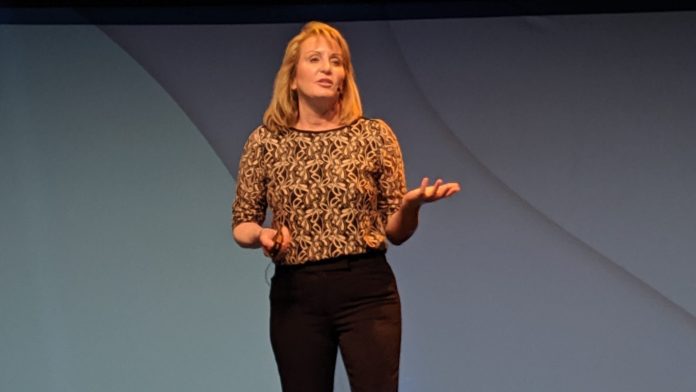The LoRa Alliance set out its stall at The Things Conference, an annual LoRaWAN meetup in Amsterdam, with an agenda to make the IoT market simpler for developers, device makers, and enterprise customers, so it achieves massive scale, finally.
Donna Moore, chair of the alliance, told the event, run by Netherlands-based LoRaWAN group The Things Network, that a strategy is being developed to simplify the marketing of low-power wide-area IoT solutions, to focus on “kick-ass” use cases, and at the same time to expand technical functions and spectrum access so LoRaWAN can capture new use cases.
“The message is we know IoT is so complicated. It requires an entire ecosystem, a village, to make it happen, with networks and devices. And it is more about the ecosystem, and less about the technology. The alliance is focusing on two things – to simplify and expand – and the board has created a new strategy with its members,” she said.
That strategy is being saved for a new event, called the LoRaWAN World Expo, in Paris on June 9 and 10. But Moore suggested the marketing of LoRaWAN, a key task for the alliance, should be refined, along with the LoRaWAN standard itself, even as the technology advances.
“We are looking to simplify the message – to make it about solving problems, and about increasing revenues and reducing costs. Because there are too many verticals. We will focus on priority use cases. We have to prioritize, and make sure we kick-ass in certain areas, around specific use cases,” she said.
The message, here, was about how LoRaWAN is handled in marketing terms. As a real-world application, the story is different, she suggested; the alliance will seek to standardize new spectrum, with the 2.4 GHz band under review already, and functions in the technology to capture new share of the LPWA-based IoT market.
She said: “The second part is [about] expansion, which is about expanding spectrum so you can grow to new global areas, and expanding feature sets so you can address new use cases, so you can keep adding them on.”
She added: “We have a taskforce and working group dedicated to keeping and securing additional spectrum. We have consultants and lobbyists to go out and secure new spectrum so everyone can grow.”
At the same event, Wienke Giezman, chief executive and co-founder of The Things Network and The Things Industries, made clear LoRaWAN, which has so far occupied various sub-GHz bands in different regions, is destined also for the 2.4 GHz band, pointing to the availability of gateways and devices at 2.4 GHz, and the first live 2.4 GHz deployment with maritime group Wilhelmsen.
The LoRa Alliance has prioritized 2.4 GHz compatibility in its working groups, but said also that the move may be too soon for the LoRaWAN community, and that a final decision is still to be made. “It is on the table,” remarked Alper Yegin, who heads the LoRa Alliance technical committee, said in a keynote about the future path of the technology.
He said: “We have this prioritization activity, because a lot of features are coming into the LoRa Alliance, and even though we look like a big crowd, we are in fact at the infancy of the ecosystem, and we need to respect its capacity to absorb new features. For that reason, we are going through this activity, but that is all I can say.”
Moore was otherwise preaching to the converted, in Amsterdam, telling a packed room of dyed-in-the-wool LoRaWAN enthusiasts that their preferred IoT tech was here to stay. “We just deal in facts. Lets scrap the analyst slides, about predictions. The best predictor of future success is past performance,” she said.
“We have seen growth from enterprises, and companies talking about growth. We have over 130 operators around the world, and we’ve added 10 in the last few months. LoRaWAN offers flexibility in terms of business models – op-ex, cap-ex, public, private. It has the greatest footprint of any LPWAN out there, in 143 countries. We also have the greatest number of devices, with 245 that are certified.”
She drew attention to American Tower’s work in Brazil, which claims to have doubled its LoRaWAN network in 2019 to 220 cities, covering 100 million people in the country. Despite the stated strategy to bring scale, she described growth in 2019 as “astronomical”.
She said: “Normally, solutions look for problems. But the market is driving so strongly – the market is calling for help. The market wants it. If you’re not developing and certifying LoRaWAN networks now, you are missing out. Because these contracts are 10-50 years’ long.”
Moore went on, as well, about the size of the ecosystem too. But the certification of IoT devices was the key point, beyond the strategizing about spectrum and marketing. “These devices are meant to last 10-15 years. You have to certify. You cannot be at scale without certifying devices,” she said.
“People say it is expensive. But it is expensive when you deploy projects that have issues in the field. That is when it gets expensive. And as we move forward, governments and enterprises will not buy devices that are not certified. Think of Wi-Fi; the reason why you certify devices is to get to that ROI faster.”
The LoRa Alliance is offering a free LoRaWAN certification test tool, allowing members to verify their devices have been certified.

